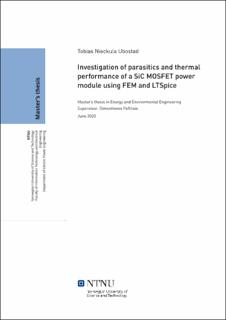| dc.contributor.advisor | Dimosthenis Peftitsis | |
| dc.contributor.author | Ubostad, Tobias Nieckula | |
| dc.date.accessioned | 2021-09-15T17:15:32Z | |
| dc.date.available | 2021-09-15T17:15:32Z | |
| dc.date.issued | 2020 | |
| dc.identifier | no.ntnu:inspera:54192396:20651664 | |
| dc.identifier.uri | https://hdl.handle.net/11250/2778233 | |
| dc.description.abstract | I denne masteroppgaven analyseres ytelsen til SiC halvbro-modulen CAS300M12BM2 fra Cree gjennom datasimuleringsverktøy. De viktigste bidragsyterne til parasittisk induktans i modulen har blitt identifisert og deres innvirkning på svitsjekarakteristikken blir studert. Videre utføres en termisk analyse for å studere temperaturfordelingen i modulen.
En modell av modulen er utviklet i ANSYS slik at den kan etterligne den kommersielt tilgjengelige modulen fra Cree. Q3D Extractor ble brukt til å trekke ut de parasittiske induktansene og motstandene til modulen. Dobbel-puls tester i LTSpice ble gjennomført for å vurdere modulens svitsje-ytelse og effekten av parasittisk induktans. Videre ble en forbedret utforming av modulens kraftterminaler undersøkt.
Studien fant at modulen ikke er egnet for drift under høy temperatur på grunn av den spesifikke plasseringen av SiC MOSFET chippene. FEM-simuleringene avslørte også at de store kraftterminalene er hovedkilden til parasittisk induktans i modulen. Analysen i LTSpice viste at disse induktansene fører til overspenninger og oscillasjoner i strøm- og spenningsbølgene.
Videre ble tre forbedrede utforminger av hovedterminalene til modulen foreslått og undersøkt, slik at overspenningene og oscillasjonene kan reduseres. De foreslåtte terminalene tar større nytte av magnetiske fluksannulerende effekter, og reduserer effektivt den totale strømsløyfeinduktansen til modulen. Simuleringer av de nye terminalene i LTSpice viste at overspenningene blir redusert og svitsjeenergien ble redusert derav. | |
| dc.description.abstract | In this thesis, the performance of the half-bridge SiC power module CAS300M12BM2 from Cree is analyzed through computer simulation tools. The largest contributors to the parasitic inductance internal to the module are identified and their impact on switching performance is studied. Furthermore, a thermal analysis is performed to study the temperature distribution in the module.
A model of the module has been developed in ANSYS so that it can emulate the commercially available module from Cree. Q3D Extractor was used to extract the parasitic inductances and resistances of the module. Double-pulse tests in LTSpice were used to assess the switching performance and the effect of stray inductance. Moreover, an improved design for the power terminals of the module was investigated.
Through the investigation is was found that the module is not properly fit for high-temperature operation due the specific placement of SiC MOSFET dies. The FEM simulations did also reveal that the large power terminals are the main source of stray inductance in the module. The analysis in LTSpice showed that these stray inductance lead to voltage overshoots and ringing in the current and voltage waveforms.
Consequently, a three improved new power terminal designs were suggested and investigated so that the voltage overshoots and oscillations could be reduced. The suggested terminals take a larger advantage of magnetic flux cancelling effects, which effectively reduce the total power loop inductance in the module. Simulations of the new design in LTSpice showed that the voltage overshoots were reduced and there was an improvement to the switching energy. | |
| dc.language | | |
| dc.publisher | NTNU | |
| dc.title | Investigation of parasitics and thermal performance of a SiC MOSFET power module using FEM and LTSpice | |
| dc.type | Master thesis | |
